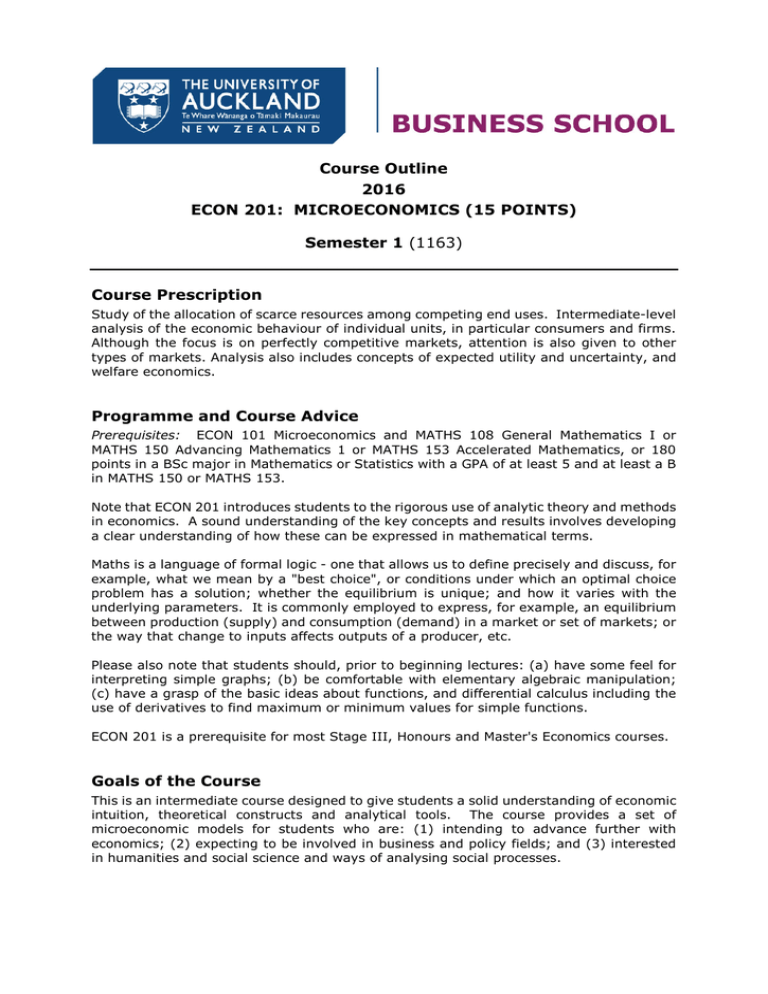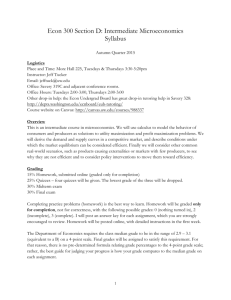Course Outline 2016 ECON 201: MICROECONOMICS (15 POINTS)
advertisement

Course Outline 2016 ECON 201: MICROECONOMICS (15 POINTS) Semester 1 (1163) Course Prescription Study of the allocation of scarce resources among competing end uses. Intermediate-level analysis of the economic behaviour of individual units, in particular consumers and firms. Although the focus is on perfectly competitive markets, attention is also given to other types of markets. Analysis also includes concepts of expected utility and uncertainty, and welfare economics. Programme and Course Advice Prerequisites: ECON 101 Microeconomics and MATHS 108 General Mathematics I or MATHS 150 Advancing Mathematics 1 or MATHS 153 Accelerated Mathematics, or 180 points in a BSc major in Mathematics or Statistics with a GPA of at least 5 and at least a B in MATHS 150 or MATHS 153. Note that ECON 201 introduces students to the rigorous use of analytic theory and methods in economics. A sound understanding of the key concepts and results involves developing a clear understanding of how these can be expressed in mathematical terms. Maths is a language of formal logic - one that allows us to define precisely and discuss, for example, what we mean by a "best choice", or conditions under which an optimal choice problem has a solution; whether the equilibrium is unique; and how it varies with the underlying parameters. It is commonly employed to express, for example, an equilibrium between production (supply) and consumption (demand) in a market or set of markets; or the way that change to inputs affects outputs of a producer, etc. Please also note that students should, prior to beginning lectures: (a) have some feel for interpreting simple graphs; (b) be comfortable with elementary algebraic manipulation; (c) have a grasp of the basic ideas about functions, and differential calculus including the use of derivatives to find maximum or minimum values for simple functions. ECON 201 is a prerequisite for most Stage III, Honours and Master's Economics courses. Goals of the Course This is an intermediate course designed to give students a solid understanding of economic intuition, theoretical constructs and analytical tools. The course provides a set of microeconomic models for students who are: (1) intending to advance further with economics; (2) expecting to be involved in business and policy fields; and (3) interested in humanities and social science and ways of analysing social processes. 2. ECON 201 Course Outline 2016 Learning Outcomes By the end of this course it is expected that the student will: 1. know the basic principles of microeconomics; 2. understand the building blocks that underpin demand and supply, models of market structure and models involving externalities and public goods; 3. be familiar with the structure of economic models; 4. be able to derive solutions to a wide range of economic models; 5. be able to describe and discuss their results; and 6. be acquainted with the application of the models to real-world situations. Content Outline Each topic will be covered in approximately one week. Topic 1: Introduction and Mathematics Review (Perloff: Chapters 1 & 2, Mathematical Appendix) Topic 2: Consumer Preference and Utility (Perloff: Chapter 3) Topic 3: Consumer Choice and Demand (Perloff: Chapters 4 & 5) Topic 4: Production Functions and Cost Minimization (Perloff: Chapters 6 & 7) Topic 5: Producer Cost Curves and Equilibrium (Perloff: Chapters 7 & 8) Topic 6: Competitive Markets (Perloff: Chapters 8 & 9) Topic 7: Game Theory (Perloff: Chapter 17) Topic 8: Monopoly (Perloff: Chapters 11 & 12) Topic 9: Oligopolistic Markets and Strategic Behaviour (Perloff: Chapters 13 & 14) Topic 10: Asymmetric information and Uncertainty (Perloff: Chapters 17 & 18) Topic 11: General Equilibrium (Perloff: Chapter 10) Topic 12: Externalities and Public Goods (Perloff: Chapters 16 & 19) Learning and Teaching There are three one-hour lectures Tutorials are aimed at providing an opportunity to tackle problems – usually 2 per tutorial - in small groups and participants will be asked to provide their solutions to the tutorial group. Tutorial problems are included in the course book and solutions will be posted on CANVAS at the end of each week. The problem solving sessions in Tutorials are designed to supplement and complement lectures, both form an intrinsic part of the course. Attendance is strongly advised. Please attempt the tutorial questions before coming to the tutorial. Teaching Staff Professor Basil Sharp Office: OGGB 655 Tel: 923 5366 Email: b.sharp@auckland.ac.nz 3. ECON 201 Course Outline 2016 Learning Resources Prescribed Text: Jeffrey M. Perloff, Microeconomics with Calculus, 2nd edition, 2011, Pearson Education. Please note that Perloff provides supplementary reading. Lectures will be based on the Coursebook. A Coursebook containing powerpoint lecture slides and tutorial questions will be available from the Business and Economics Student Bookshop, Level 0, Owen G. Glenn Building. Assessment Coursework is worth 45% of the total mark, consisting of one Test worth 30% and two Assignments worth 7.5% each; and the Final Examination is worth 55%. Plussage does NOT apply. Mid Semester Test Dates Semester 1 - Week 7 – Tuesday, 12th April 2016 More details will be provided at lectures and on Canvas. Assignments are aimed at reinforcing the material covered in class and in tutorials. Each assignment will cover approximately one-third of the course material. Tutorial questions and practice sets provide an indication of the standard required and an opportunity to develop problem solving skills. Assignments will be distributed via CANVAS only. They are to be submitted to the Business and Economics Student Centre by 4.00pm on the due date (approximately as follows): Assignment 1 Assignment 2 Friday, 1st April, 2016 Friday, 20th May, 2016 The Test and Final Exam each provide an opportunity for the student to demonstrate not only their knowledge of microeconomic models and problem solving skills but also their ability to describe and discuss their results. Learning Outcome 1 2 3 4 5 6 Test X X X X X X Assignments 1 and 2 X X X X X X Final Examination X X X X X X






